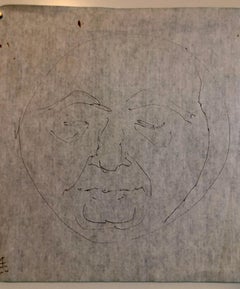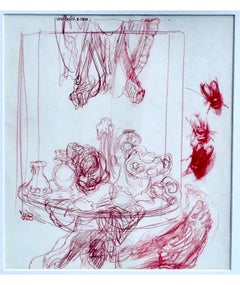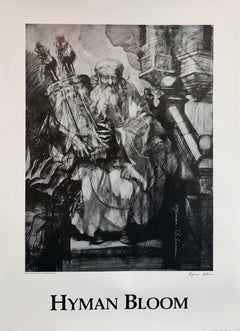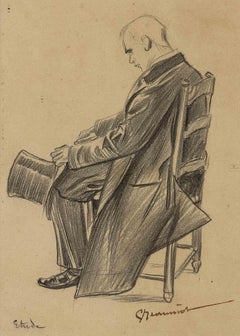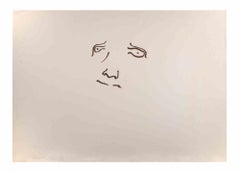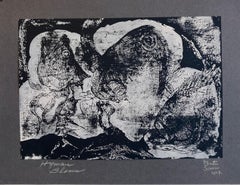Hyman Bloom Art
to
3
3
1
1
Boston Abstract Expressionist Hyman Bloom Original Pencil Drawing Martin Sumers
By Hyman Bloom
Located in Surfside, FL
This is a unique artwork. This is an original Hyman Bloom drawing of fellow artist and his very good friend Martin Sumers.I believe this was drawn at the “variations of a theme” at S...
Category
20th Century Modern Hyman Bloom Art
Materials
Paper, Pencil
Boston Expressionist Conte Pencil Drawing "Still Life with Flies" Hyman Bloom
By Hyman Bloom
Located in Surfside, FL
Hyman Bloom
"Still Life with Flies"
Frame: 18" X 16"
Image: 9.25" X 8.25"
Hand signed with his monogram initials
Provenance: bears exhibition label from Fuller Museum of Art
Hyman B...
Category
1990s Abstract Hyman Bloom Art
Materials
Color Pencil
Abstract Expressionist Hyman Bloom Judaica Hand Signed Poster Rabbi with Torah
By Hyman Bloom
Located in Surfside, FL
This is not editioned. According to his wife this was done privately for his 80th birthday and just given to friends and family. they were not sold. This is from a group of very few ...
Category
20th Century Modern Hyman Bloom Art
Materials
Offset
Related Items
Siiting Man - Drawing By Pierre Georges Jeanniot - Late 19th Century
By Pierre Georges Jeanniot
Located in Roma, IT
Siiting man is a modern artwork realized by Pierre- Georges Jeanniot in the Late 19th Century
Pencil drawing.
Includes frame: 30.5 x 3 x...
Category
Late 19th Century Modern Hyman Bloom Art
Materials
Paper, Pencil
$569
H 9.85 in W 7.68 in D 0.08 in
Portrait - Drawing By Reynold Arnould - 1970
Located in Roma, IT
Portrait is a Black Marker Drawing realized by Reynold Arnould (Le Havre 1919 - Parigi 1980).
Good condition on a white paper.
No signature.
Reynold Arnould was born in Le Havre...
Category
1970s Modern Hyman Bloom Art
Materials
Paper, Pencil
$332
H 11.62 in W 16.54 in D 0.08 in
Untitled Floral Still Life
Located in Wilton Manors, FL
Beautiful floral still life by American artist Jane Piper (1916-1991) . Pastel, oil crayon and pencil on tracing paper. Image measuring 13 x 15.5 inches in ...
Category
1980s Abstract Hyman Bloom Art
Materials
Parchment Paper, Crayon, Pastel, Pencil
Original Bally-Chaussures-Globe vintage fashion poster
By Bernard Villemot
Located in Spokane, WA
Original poster: BALLY, a.k.a. Bally Kick and Bally Globe.
Artist: Bernard Villemot. Ready to frame. Note that this is the small format version of the poster. Museum linen backed. A poster that is a combination of both art and advertisement. This is one of the last posters that Villemot created. Grade A Condition.
The image shows a woman kicking up her heel, while her shadow is that of a man's leg and shoe. The globe in the background shows that Bally is a worldwide company.
Add a touch of elegance and nostalgia to your space with this stunning original Bally vintage poster...
Category
1980s Modern Hyman Bloom Art
Materials
Offset
$649
H 23.5 in W 16 in D 0.05 in
LIDO " Gala Revue" Pourquoi pas! original French cabaret poster, linen-backed
By René Gruau
Located in Spokane, WA
Original Lido “Gala Revue” Pourquoi pas!, linen-backed French cabaret poster by famed artist Rene Gruau. Very fine, grade A condition.
The image of an elegant woman in her cabaret...
Category
Late 20th Century American Modern Hyman Bloom Art
Materials
Offset
$350
H 23.75 in W 15.5 in D 0.3 in
Original Baby in bidet - Manifattura Ceramica Pozzi vintage Italian poster
By Gino Boccasile
Located in Spokane, WA
Original poster showing a “Baby in a Bidet”. In Italian it is Maniffatura Ceramica Pozzi. Linen backed in very fine condition, ready to frame. This Italian poster was only know...
Category
1950s American Modern Hyman Bloom Art
Materials
Offset
$299
H 13 in W 9.5 in D 0.1 in
Original Bravissimo Lido Paris Cabaret vintage poster small format poster
By René Gruau
Located in Spokane, WA
Original Bravissimo Lido (Small format), artist Rene Gruau. Size: 15.5" x 23.5". Archival linen-backed vintage original French cabaret poster, ready to frame. “Bravissimo” was ...
Category
Late 20th Century American Modern Hyman Bloom Art
Materials
Offset
$350
H 23.5 in W 15.5 in D 0.02 in
Untitled Floral Still Life
Located in Wilton Manors, FL
Beautiful floral still life by American artist Jane Piper (1916-1991) .
Untitled. 1980.
Pastel, oil crayon and pencil on tracing paper. Image measuring 9 x 12 inches in original ...
Category
1980s Abstract Hyman Bloom Art
Materials
Parchment Paper, Crayon, Pastel, Pencil
Untitled No. 26 (Modern Black & Grey Abstract Fruit Drawing in Black Frame)
By Ralph Stout
Located in Hudson, NY
Vertical charcoal drawing on Arches paper
18 x 13 inches unframed
25 x 20 inches in black metal frame with AR non-glare glass & 8-ply mat
This contemporary, abstract charcoal drawin...
Category
Early 2000s Abstract Hyman Bloom Art
Materials
Paper, Charcoal
$960 Sale Price
20% Off
H 25 in W 20 in D 1.5 in
Bountiful
Located in Brooklyn, NY
This black and white abstract drawing features a beautiful floral.
Framed in a vintage gold frame, wired and ready to hang, 11 in. wide x 13 in. high
Category
2010s Abstract Hyman Bloom Art
Materials
Archival Ink
Cappiello's Contratto Canelli Vermouth - later printing
By Leonetto Cappiello
Located in Spokane, WA
Original Contratto Canelli Vermouth vintage Italian liquor poster. Archival linen backed and ready to frame. Very good condition. This is the later c.1950 lithograph printing of the poster. Beautiful advertising vintage affiche printed in offset lithography (second edition). There is no second printing date besides the original date inside the poster by Cappiello's signature.
(Note that the earlier printing sells for about $9500.)
Most standard size original Italian posters are 39" x 55" in size; or 27.5" x 39 half sheets.
This is currently the lowest and best price for this Cappiello Contratto poster on 1st Dibs.
The woman in this Cappiello poster rests on a large green maple leaf while holding a bottle of Vermouth Victor and a bottle of Vermouth Bianco...
Category
Late 20th Century American Modern Hyman Bloom Art
Materials
Offset
Original pre-release 'Indiana Jones and the Temple of Doom' vintage poster
Located in Spokane, WA
Original movie poster, Linen-backed original Indiana Jones and the Temple of Doom pre-release. "Coming May 23rd, 1984.
Indiana Jones and the Temple of Doom, the 1984 Steven Spielberg treasure-hunting action-adventure fantasy sequel ("If adventure has a name... It must be Indiana Jones."; "Trust him."
Starring: Harrison Ford, Kate Capshaw, Jonathan Ke Quan, Amrish Puri, Roshan Seth, Philip Stone...
Category
1980s American Modern Hyman Bloom Art
Materials
Offset
$476 Sale Price
20% Off
H 40 in W 27 in D 0.05 in
Previously Available Items
Boston Abstract Expressionist Hyman Bloom Original Pencil Drawing Martin Sumers
By Hyman Bloom
Located in Surfside, FL
This is a unique artwork. This is an original Hyman Bloom drawing of fellow artist and his very good friend Martin Sumers.I believe this was drawn at the “variations of a theme” at Sumers gallery in NYC. The last two photos show a poster and a card from their shows. it is not included in this listing, it is just for provenance.
Provenance: Acquired from the Sumers estate collection.
Hyman Bloom (March 29, 1913 – August 26, 2009) was a Latvian-born American painter. His work was influenced by his Jewish heritage and Eastern religions as well as by artists including Altdorfer, Grünewald, Caravaggio, Rembrandt, Blake, Bresdin, James Ensor and Chaim Soutine. He first came to prominence when his work was included in the 1942 Museum of Modern Art exhibition "Americans 1942 -- 18 Artists from 9 States". MoMA purchased 2 paintings from the exhibition and Time magazine singled him out as a "striking discovery" in their exhibition review.
His work was selected for both the 1948 and 1950 Venice Biennale exhibitions and his 1954 retrospective traveled from Boston's Institute of Contemporary Art to the Albright Gallery and the de Young Museum before closing out at The Whitney Museum of American Art in 1955. In a 1954 interview with Yale art professor Bernard Chaet, Willem de Kooning indicated that he and Jackson Pollock both considered Bloom to be “America’s first abstract expressionist”, a label that Bloom would disavow. Starting in the mid 1950s his work began to shift more towards works on paper and he exclusively focused on drawing throughout the 1960s, returning to painting in 1971. He continued both drawing and painting until his death in 2009 at the age of 9
Hyman Bloom (né Melamed) was born into an orthodox Jewish family in the tiny Jewish village of Brunavišķi in what is now Latvia, then part of the Russian Empire
At a young age Bloom planned to become a rabbi, but his family could not find a suitable teacher. In the eighth grade he received a scholarship to a program for gifted high school students at the Museum of Fine Arts. He attended the Boston High School of Commerce, which was near the museum. He also took art classes at the West End Community Center, a settlement house. The classes were taught by Harold Zimmerman, a student at the School of the Museum of Fine Arts, who also taught the young Jack Levine at another settlement house in Roxbury. When Bloom was fifteen, he and Levine began studying with a well-known Harvard art professor, Denman Ross, who rented a studio for the purpose and paid the boys a weekly stipend to enable them to continue their studies rather than take jobs to support their families.
He took Bloom and Levine on a field trip to the Museum of Modern Art in New York, where Bloom was impressed by the work of Rouault and Soutine and began experimenting with their expressive painting styles.
In the 1930s Bloom worked sporadically for the Public Works of Art Project and the Federal Art Project (WPA), He shared a studio in the South End with Levine and another artist, Betty Chase. It was during this period that he developed a lifelong interest in Eastern philosophy and music, and in Theosophy.
He first received national attention in 1942 when thirteen of his paintings were included in the Museum of Modern Art (MoMA) exhibition Americans 1942: 18 Artists from 9 States, curated by Dorothy Miller. MoMA purchased two of his paintings from that exhibition, and he was featured in Time magazine. The titles of his paintings in the exhibition reflect some of his recurring themes. Two were titled The Synagogue, another, Jew with the Torah; Bloom was actually criticized by one reviewer for including "stereotypical" Jewish images. He also had two paintings titled The Christmas Tree, and another titled The Chandelier, both subjects he returned to repeatedly. Another, Skeleton (c. 1936), was followed by a series of cadaver paintings in the forties, and The Fish (c. 1936) was one of many paintings and drawings of fish he created over the course of his career.
Bloom was associated at first with the growing Abstract Expressionist movement. Willem de Kooning and Jackson Pollock, who first saw Bloom's work at the MoMA exhibition, considered Bloom "the first Abstract Expressionist artist in America." In 1950 he was chosen, along with the likes of de Kooning, Pollock, and Arshile Gorky, to represent the United States at the Venice Biennale. That same year Elaine de Kooning wrote about Bloom in ARTnews, noting that in paintings such as The Harpies, his work approached total abstraction: "the whole impact is carried in the boiling action of the pigment". In 1951 Thomas B. Hess reproduced Bloom's Archaeological Treasure in his first book, Abstract Painting: Background and American Phase, along with works by Picasso, Pollock, and others. Both de Kooning and Hess remarked on Bloom's expressive paint handling, a key characteristic of Abstract Expressionist painting.
As abstract expressionism dominated the American art world, Bloom became disenchanted with it, calling it "emotional catharsis, with no intellectual basis." In addition, instead of moving to New York to pursue his career, he opted to stay in Boston. As a result he fell out of favor with critics and never achieved the kind of fame that Pollock and others did. He disliked self-promotion and never placed much value on critical acclaim.
Many of Bloom's paintings feature rabbis, usually holding the Torah. According to Bloom, his intentions were more artistic than religious. He began questioning his Jewish faith early in life, and painted rabbis, he claimed, because that was what he knew. Over the course of his career he produced dozens of paintings of rabbis...
Category
20th Century Modern Hyman Bloom Art
Materials
Paper, Pencil
Boston Abstract Expressionist Hyman Bloom Monoprint Monotype Print Martin Sumers
By Hyman Bloom
Located in Surfside, FL
This is a unique artwork. This is not editioned. This is an exceptional single print which was part of a collaboration between him and fellow artist and his very good friend Martin S...
Category
20th Century Modern Hyman Bloom Art
Materials
Monoprint, Monotype
Boston Abstract Expressionist Hyman Bloom Monoprint Monotype Print Martin Sumers
By Hyman Bloom
Located in Surfside, FL
This is a unique artwork. This is not editioned. This is an exceptional single print which was part of a collaboration between him and fellow artist and his very good friend Martin S...
Category
20th Century Modern Hyman Bloom Art
Materials
Monoprint, Monotype
Boston Abstract Expressionist Hyman Bloom Monoprint Monotype Print Martin Sumers
By Hyman Bloom
Located in Surfside, FL
This is a unique artwork. This is not editioned. This is an exceptional single print which was part of a collaboration between him and fellow artist and his very good friend Martin S...
Category
20th Century Modern Hyman Bloom Art
Materials
Monoprint, Monotype
Boston Abstract Expressionist Hyman Bloom Monoprint Monotype Print Martin Sumers
By Hyman Bloom
Located in Surfside, FL
This is a unique artwork. This is not editioned. This is an exceptional single print which was part of a collaboration between him and fellow artist and his very good friend Martin S...
Category
20th Century Modern Hyman Bloom Art
Materials
Monoprint, Monotype
Boston Abstract Expressionist Hyman Bloom Monoprint Monotype Print Martin Sumers
By Hyman Bloom
Located in Surfside, FL
This is a unique artwork. This is not editioned. This is an exceptional single print which was part of a collaboration between him and fellow artist and his very good friend Martin S...
Category
20th Century Modern Hyman Bloom Art
Materials
Monoprint, Monotype
Abstract Expressionist Hyman Bloom Judaica Hand Signed Poster Rabbi with Torah
By Hyman Bloom
Located in Surfside, FL
This is not editioned. According to his wife this was done privately for his 80th birthday and just given to friends and family. they were not sold. This is from a group of very few that were hand signed by Hyman Bloom for his close friend the artist Martin Sumers. It depicts a 1955 charcoal drawing Rabbi with Torah.
Provenance: Acquired from the Martin Sumers estate collection.
Hyman Bloom (March 29, 1913 – August 26, 2009) was a Latvian-born American painter. His work was influenced by his Jewish heritage and Eastern religions as well as by artists including Altdorfer, Grünewald, Caravaggio, Rembrandt, Blake, Bresdin, James Ensor and Chaim Soutine. He first came to prominence when his work was included in the 1942 Museum of Modern Art exhibition "Americans 1942 -- 18 Artists from 9 States". MoMA purchased 2 paintings from the exhibition and Time magazine singled him out as a "striking discovery" in their exhibition review.
His work was selected for both the 1948 and 1950 Venice Biennale exhibitions and his 1954 retrospective traveled from Boston's Institute of Contemporary Art to the Albright Gallery and the de Young Museum before closing out at The Whitney Museum of American Art in 1955. In a 1954 interview with Yale art professor Bernard Chaet, Willem de Kooning indicated that he and Jackson Pollock both considered Bloom to be “America’s first abstract expressionist”, a label that Bloom would disavow. Starting in the mid 1950s his work began to shift more towards works on paper and he exclusively focused on drawing throughout the 1960s, returning to painting in 1971. He continued both drawing and painting until his death in 2009 at the age of 9
Hyman Bloom (né Melamed) was born into an orthodox Jewish family in the tiny Jewish village of Brunavišķi in what is now Latvia, then part of the Russian Empire
At a young age Bloom planned to become a rabbi, but his family could not find a suitable teacher. In the eighth grade he received a scholarship to a program for gifted high school students at the Museum of Fine Arts. He attended the Boston High School of Commerce, which was near the museum. He also took art classes at the West End Community Center, a settlement house. The classes were taught by Harold Zimmerman, a student at the School of the Museum of Fine Arts, who also taught the young Jack Levine at another settlement house in Roxbury. When Bloom was fifteen, he and Levine began studying with a well-known Harvard art professor, Denman Ross, who rented a studio for the purpose and paid the boys a weekly stipend to enable them to continue their studies rather than take jobs to support their families.
He took Bloom and Levine on a field trip to the Museum of Modern Art in New York, where Bloom was impressed by the work of Rouault and Soutine and began experimenting with their expressive painting styles.
In the 1930s Bloom worked sporadically for the Public Works of Art Project and the Federal Art Project (WPA), He shared a studio in the South End with Levine and another artist, Betty Chase. It was during this period that he developed a lifelong interest in Eastern philosophy and music, and in Theosophy.
He first received national attention in 1942 when thirteen of his paintings were included in the Museum of Modern Art (MoMA) exhibition Americans 1942: 18 Artists from 9 States, curated by Dorothy Miller. MoMA purchased two of his paintings from that exhibition, and he was featured in Time magazine. The titles of his paintings in the exhibition reflect some of his recurring themes. Two were titled The Synagogue, another, Jew with the Torah; Bloom was actually criticized by one reviewer for including "stereotypical" Jewish images. He also had two paintings titled The Christmas Tree, and another titled The Chandelier, both subjects he returned to repeatedly. Another, Skeleton (c. 1936), was followed by a series of cadaver paintings in the forties, and The Fish (c. 1936) was one of many paintings and drawings of fish he created over the course of his career.
Bloom was associated at first with the growing Abstract Expressionist movement. Willem de Kooning and Jackson Pollock, who first saw Bloom's work at the MoMA exhibition, considered Bloom "the first Abstract Expressionist artist in America." In 1950 he was chosen, along with the likes of de Kooning, Pollock, and Arshile Gorky, to represent the United States at the Venice Biennale. That same year Elaine de Kooning wrote about Bloom in ARTnews, noting that in paintings such as The Harpies, his work approached total abstraction: "the whole impact is carried in the boiling action of the pigment". In 1951 Thomas B. Hess reproduced Bloom's Archaeological Treasure in his first book, Abstract Painting: Background and American Phase, along with works by Picasso, Pollock, and others. Both de Kooning and Hess remarked on Bloom's expressive paint handling, a key characteristic of Abstract Expressionist painting.
As abstract expressionism dominated the American art world, Bloom became disenchanted with it, calling it "emotional catharsis, with no intellectual basis." In addition, instead of moving to New York to pursue his career, he opted to stay in Boston. As a result he fell out of favor with critics and never achieved the kind of fame that Pollock and others did. He disliked self-promotion and never placed much value on critical acclaim.
Many of Bloom's paintings feature rabbis, usually holding the Torah. According to Bloom, his intentions were more artistic than religious. He began questioning his Jewish faith early in life, and painted rabbis, he claimed, because that was what he knew. Over the course of his career he produced dozens of paintings of rabbis...
Category
20th Century Modern Hyman Bloom Art
Materials
Offset
Boston Abstract Expressionist Hyman Bloom Monoprint Monotype Print Martin Sumers
By Hyman Bloom
Located in Surfside, FL
This is a unique artwork. This is not editioned. This is an exceptional single print which was part of a collaboration between him and fellow artist and his very good friend Martin S...
Category
20th Century Modern Hyman Bloom Art
Materials
Monoprint, Monotype
Hyman Bloom art for sale on 1stDibs.
Find a wide variety of authentic Hyman Bloom art available for sale on 1stDibs. You can also browse by medium to find art by Hyman Bloom in offset print, paper, pencil and more. Much of the original work by this artist or collective was created during the 20th century and is mostly associated with the modern style. Not every interior allows for large Hyman Bloom art, so small editions measuring 14 inches across are available. Customers who are interested in this artist might also find the work of Alfred Bendiner, Frank Kleinholz, and Knox Martin. Hyman Bloom art prices can differ depending upon medium, time period and other attributes. On 1stDibs, the price for these items starts at $850 and tops out at $1,200, while the average work can sell for $1,025.
